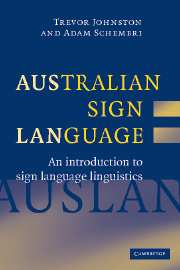Book contents
- Frontmatter
- Contents
- Acknowledgements
- Conventions for sign notation
- 1 Signed languages and linguistics
- 2 Auslan in social context
- 3 Auslan and other signed languages
- 4 Phonetics and phonology: the building blocks of signs
- 5 Morphology: sign formation and modification
- 6 Lexicon: the structure of Auslan vocabulary
- 7 Syntax: the structure of sentences in Auslan
- 8 Semantics and pragmatics: sign meaning and sentence meaning
- 9 Discourse: structure and use above the sentence
- 10 Issues in the study of signed languages
- References
- Index
9 - Discourse: structure and use above the sentence
Published online by Cambridge University Press: 02 December 2009
- Frontmatter
- Contents
- Acknowledgements
- Conventions for sign notation
- 1 Signed languages and linguistics
- 2 Auslan in social context
- 3 Auslan and other signed languages
- 4 Phonetics and phonology: the building blocks of signs
- 5 Morphology: sign formation and modification
- 6 Lexicon: the structure of Auslan vocabulary
- 7 Syntax: the structure of sentences in Auslan
- 8 Semantics and pragmatics: sign meaning and sentence meaning
- 9 Discourse: structure and use above the sentence
- 10 Issues in the study of signed languages
- References
- Index
Summary
Discourse is the term used to refer to any group of sentences in a language (either spoken, signed or written) that has a coherent meaning for someone who knows the language. An understanding of discourse structure depends on an understanding of language in use. In this chapter, therefore, we will focus on how aspects of the grammatical structure of Auslan are used to create clear and coherent communication.
The study of discourse is often defined as the study of texts (Crystal, 1997). Strictly speaking, text refers to any coherent sequence of written sentences, as in a letter, article or novel. Its use is often extended, however, so that it may also refer to any coherent series of spoken or signed sentences as well, such as a conversation, story or lecture (Matthews, 1997). This chapter looks at some of the features of signed and spoken language texts. First, we look at how the characteristics of text reflect aspects of the situation in which it is used, before looking at some specific features of different discourse types. In particular, we look at turn-taking structure and organisational principles of conversation, and the structure of narratives. We then discuss information structure and cohesion, two important features of discourse that enable addressees to recognise the background information needed to understand texts and identify who and what is being described in extended stretches of spoken and signed language.
Register, style and genre
Speakers and signers of a particular language recognise that the variety of that language used in a particular context will vary according to aspects of the social situation.
- Type
- Chapter
- Information
- Australian Sign Language (Auslan)An introduction to sign language linguistics, pp. 253 - 278Publisher: Cambridge University PressPrint publication year: 2007

